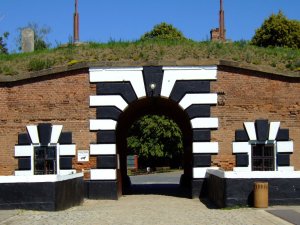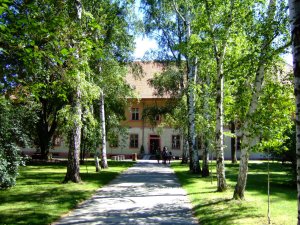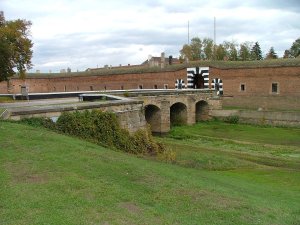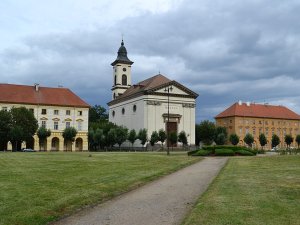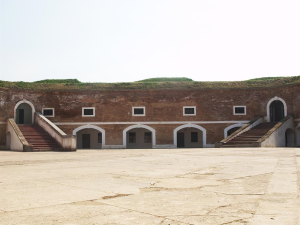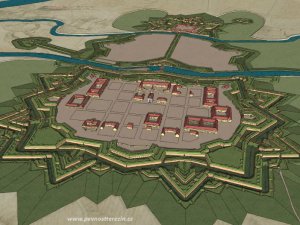TEREZÍN is a small fortress town located in the district of Litoměřice, in the Ústí Region, only two kilometres southeast of Litoměřice. The city stands on both sides of the river Ohře, which divides it into the Small and the main fortress, and north of the city flows into the Elbe.
Terezín also includes three neighbouring villages: České Kopisty, Nové Kopisty and Počaply. In total, approximately 2,900 inhabitants live in the city.
Get to know the forgotten story of the city and the fortress. Discover Terezín as you don't know it yet. Explore models of fortifications, historical plans, paintings and finds from centuries past, which will show you Terezín as a perfect fortress, a city full of life and the destinies of individual humans.
Terezín Fortress Museum:
The local museum will guide you through the story of the Terezín fortress from its foundation to the beginning of the 20th century. It's the perfect place to start your tour of the city before heading off to other sights or exploring the underground passages. Here you will learn why and how the fortress was created and how it was built. You will find out how it was to live in it and how it was torn down in the 20th century. Seven halls will guide you through the centuries and through individual themes. You will see a model of the conquest of the fortress, as well as a huge model of Terezín itself. You will see military weaponry and equipment from Maria Theresa to T. G. Masaryk. You will learn how many pubs and brothels there were in the city and many other interesting facts. Discover the forgotten story of the city as you don't know it yet.
Underground corridors:
- Terezín Fortress is one of the largest, most elaborate and best-preserved bastion fortresses in the world. It was built in the years 1780-1790 as a border fortress guarding the road from Dresden to Prague and at the same time as a huge military base full of soldiers, ammunition, weapons and food.
- The defence consists of three systems. The first and most visible is a band of up to three overlapping earth mounds in places. These progress from a covered path complete with lunettes through a side ditch to counterguards and ravelins with redoubts. Behind them is the main ditch, then a curtain covered with pincers and a wreath of eight bastions, most of which are additionally equipped with retrenchments and cavaliers. They represent the last line of defence.
- The water system of the fortress made it possible to flood the surrounding landscape and ditches inside the fortifications in a controlled manner. It allowed the defenders to dam and turn the entire Ohře river into ditches. A flood wave over three metres high was then supposed to destroy every enemy attempt to conquer the walls.
- The third system consists of tens of kilometres of underground spaces consisting of artillery casemates, powder rooms and a labyrinth of connecting, listening and mine corridors winding on several floors.
A tour of the local fortress will take you to them under the light of lanterns.
Cavalier 2:
- In the Cavalier 2, military yard, you can, among other children's activities, pet sheep, goats and Princess the pig. Adults will enjoy the jokes of the famous humorous painter and cartoonist Jiri Winter - Neprakta. Afterwards, the whole family can head off to exotic destinations offered by the La Grace Museum, with a real hold of a sailing ship roaming the seas in the 18th century.
LITOMĚRICE
is a town at the confluence of the Elbe and Ohře in northern Bohemia on the western edge of the Elbe lowland (previously the popular name was "the golden strip of the Czech land") in the district of Litoměřice in the Usti region. Litoměřice is also known as the Garden of Bohemia due to its fertile location. The total area of the city is a total of 17.99 km², approximately 23 thousand inhabitants live in the city, but together with the neighbouring towns of Terezín, Bohušovice nad Ohří and Lovosice, which are almost adjacent to Litoměřice, they form an agglomeration with almost 40 thousand inhabitants. They became a royal city between 1219 and 1228. The historical core of the city has been a city heritage reserve since 1950, which includes a total of 44 streets and nine squares.
The city has housed the bishopric of the Litoměřice diocese since 1655. Soon after its foundation, the city won a leading position in the northwestern part of Bohemia not only thanks to the royal status and numerous privileges that the city received over time, but mainly thanks to its location. The protected location from the north and west by the Bohemian Central Mountains, the navigable Elbe and the fertile region became a basic prerequisite for the wealth and development of the city. Already during the Middle Ages, Litoměřice became an important administrative and religious centre of Bohemia. What had been the town's advantage all along, i.e. its enclosure in the valley of the ending Polabska lowland between the Elbe and the emerging Bohemian Central Highlands, became its disadvantage at the age of industrial development.
The absence of suitable land for the construction of industrial areas prevented the further development of Litoměřice and enabled the rise and later dominance of industrial Ústí nad Labem. What the city has not lost, however, is its picturesqueness, atmosphere and historical monuments. Houses around the square, historic cellars, many churches, museums, several galleries and many other interesting places beckon to visit.

